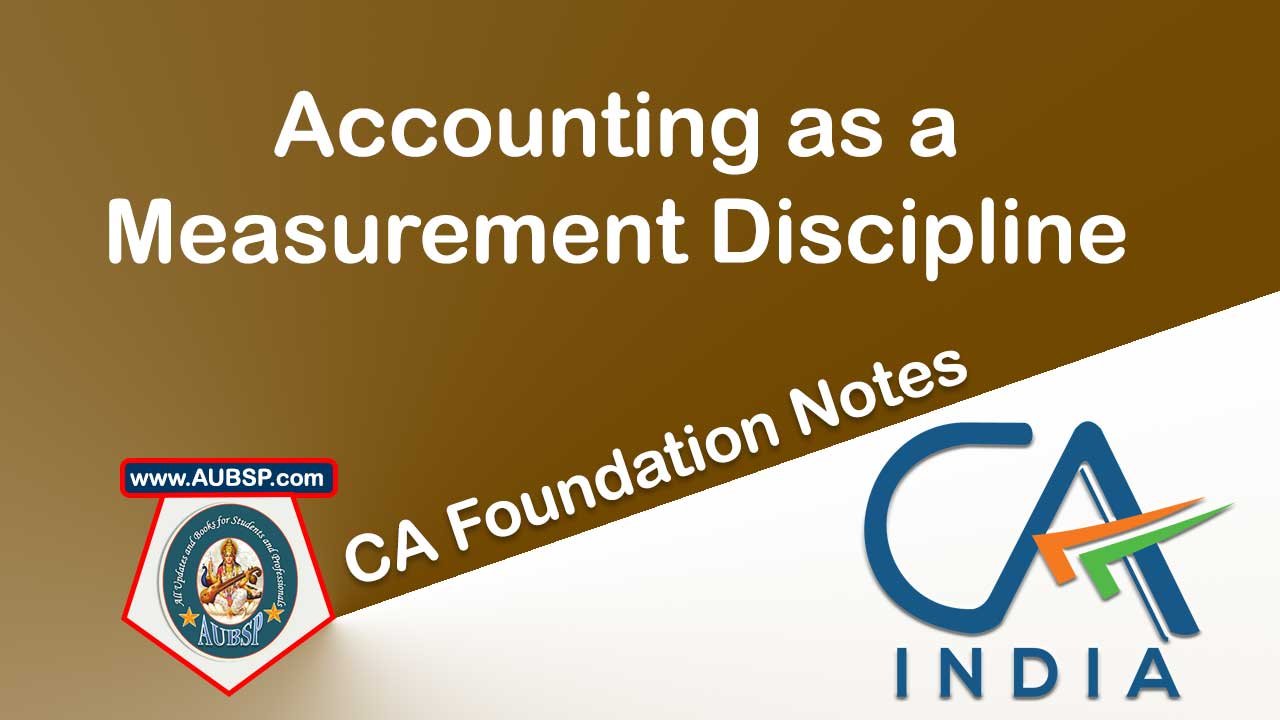Accounting as a Measurement Discipline – Valuation Principles, Accounting Estimates: Accounting as a measurement discipline involves quantifying economic transactions primarily in monetary terms to aid decision-making. It includes identifying events to be measured, selecting a scale (typically money), and evaluating its stability—though money lacks consistent value over time.
The four key valuation principles used in accounting are historical cost, current cost, realizable value, and present value, each applied based on context. Since many financial elements can’t be measured precisely due to future uncertainties, accounting relies on estimates for items like depreciation, provisions, and tax liabilities. While accounting heavily uses historical cost, it also incorporates other bases and estimates to reflect a more accurate financial picture.
Unit 6 – Accounting as a Measurement Discipline
Learning Outcomes
- Understand the meaning and elements of measurement.
- Distinguish measurement from valuation.
- Learn 4 measurement bases: Historical Cost, Current Cost, Realizable Value, Present Value.
- Grasp the role of estimates in accounting.
- Recognize that traditional accounting relies heavily on historical cost.
6.1 Measurement – Meaning & Elements
Definition: Assignment of numbers to objects/events based on specific rules (Prof. R.J. Chambers).
Elements of Measurement:
- Identification of objects/events to be measured.
- Selection of standard/scale (e.g., money).
- Evaluation of dimension of the scale (e.g., stability over time).
6.2 Objects or Events to be Measured
- Accounting measures economic information to help in decision-making.
- It includes past, present, and future data.
- Future events are not measured but predicted.
6.3 Standard or Scale of Measurement
- Money is the common scale.
- Varies by country (₹, $, £) and not universally stable due to exchange rates.
- Money lacks consistency in value over time due to inflation.
6.4 Dimension of Measurement Scale
- Ideal scale = stable over time.
- Money is not stable → creates issues in comparing across periods.
📊 Example: Sales may show 8% growth in ₹ but actually show a 10% decline in quantity due to price changes.
6.5 Accounting as a Measurement Discipline
- Involves recording, classifying, summarizing monetary transactions.
- Guided by:
- Going Concern
- Consistency
- Accrual
- Not purely measurement-focused but uses monetary units.
6.6 Valuation Principles (Measurement Bases)
| Basis | Definition | Asset Example | Liability Example | Common Usage |
|---|---|---|---|---|
| Historical Cost | Original acquisition price | Purchase cost + installation | Proceeds received | PPE, fixed assets |
| Current Cost | Cost of replacing today | Cost if purchased now | Settlement amount today | For updated reporting |
| Realizable Value | Sale price in orderly disposal | Net selling price | Payable amount | Inventory |
| Present Value | Discounted future inflows/outflows | PV of future cash inflows | PV of loan repayments | Investments, loans |
🧮 Formula:
Present Value (PV) = A / (1+i)^n
Or use Annuity Formula for multiple periods.
6.7 Measurement vs Valuation
- Value = benefits expected from an asset.
- Measurement = assigns a monetary figure to that value.
- Accounting uses cardinal numbers (₹ values), not satisfaction levels.
6.8 Accounting Estimates
Used when exact measurement isn’t possible (e.g., provision for doubtful debts).
🧠 Key Points:
- Based on judgment, past experience, available info.
- Examples:
- Patent life estimation
- Construction revenue recognition
- Tax provisions
- Change in useful life of machinery
🔁 Change in Estimate is prospective, not retrospective.
Summary Points for Revision:
- Measurement = Money-based quantification.
- 3 Elements: Identification, Scale, Dimension.
- 4 Valuation Principles:
- Historical Cost
- Current Cost
- Realizable Value
- Present Value
- Money is not a stable measurement scale.
- Accounting uses estimates where necessary.
- Change in accounting estimate ≠ retrospective change.
FAQs: Accounting as a Measurement Discipline – Unit 6
- What is measurement in accounting?
Measurement in accounting refers to assigning monetary values to business transactions and events for recording and reporting. - What are the three basic elements of measurement?
- Identification of objects/events
- Selection of standard or scale
- Evaluation of dimension of the scale
- Which scale is used for measurement in accounting?
Money is the primary scale used in accounting. - Is money a stable unit of measurement?
No, money is not stable over time due to inflation and currency fluctuations. - What is meant by dimension of measurement scale?
It refers to the stability and comparability of the measurement unit over time. - Why is accounting not considered a pure measurement discipline?
Because it also involves judgment, estimates, classification, and communication, not just measurement. - What are the four main valuation principles in accounting?
- Historical Cost
- Current Cost
- Realizable Value
- Present Value
- What is historical cost?
The original amount paid to acquire an asset or incurred to settle a liability. - What is current cost?
The amount required to acquire an equivalent asset or settle a liability at present prices. - What is realizable value?
The amount that could be obtained from selling an asset in an orderly disposal. - What is present value?
The current worth of future net cash inflows or outflows, discounted at an appropriate rate. - Which valuation principle is most commonly used in traditional accounting?
Historical cost. - What is the time value of money in present value measurement?
The concept that money available now is worth more than the same amount in the future. - What is an accounting estimate?
A value assigned when an exact measurement isn’t possible, based on past data and assumptions. - Why are accounting estimates used?
Due to uncertainty in future events, estimates help in providing reasonable financial figures. - What are examples of accounting estimates?
- Depreciation
- Provisions for bad debts
- Useful life of assets
- Tax liabilities
- What happens when an estimate changes?
It is treated prospectively; only current and future financials are affected. - What is the difference between valuation and measurement?
Valuation is assigning value (usually in money) based on benefits; measurement involves quantifying transactions. - What are cardinal and ordinal numbers in accounting?
- Cardinal: Denotes how many (used in accounting)
- Ordinal: Denotes position or rank (used in economics)
- Can a transaction have more than one valuation base?
Yes, depending on the context—different bases provide different perspectives (e.g., cost vs. market value). - Which valuation principle is commonly used for inventory?
Realizable value (specifically, the lower of cost and net realizable value). - How is present value calculated?
By discounting future cash flows using a rate of interest over time. - What is the annuity formula used in present value calculation?
PV = A × [(1 – (1 + i)^-n) / i], where A = annuity, i = interest rate, n = number of periods. - How do exchange rate fluctuations affect measurement?
They affect the comparability of financial data across countries and periods due to volatility in currency value. - Is future value a valuation principle in accounting?
No, future value is not one of the accepted valuation principles. - What is meant by book value in accounting?
The value at which an asset is recorded in the books, usually based on historical cost minus depreciation. - How does inflation impact accounting measurement?
It reduces the comparability and reliability of monetary values over time. - Which accounting assumptions influence measurement?
- Going Concern
- Consistency
- Accrual
- What role do estimates play in financial reporting?
They ensure financial statements reflect realistic and reasonable values when actual data isn’t available. - How often are accounting estimates revised?
As and when new information, experience, or changes in circumstances arise.
Accounting, while not a perfect measurement science, plays a crucial role in quantifying financial information using money as its primary scale. Despite its limitations—such as the instability of money and reliance on estimates—it effectively captures economic events through established valuation principles like historical cost, current cost, realizable value, and present value.
By applying consistent assumptions and logical estimates, accounting provides a structured framework for presenting fair and useful financial information to stakeholders, supporting informed decision-making in a dynamic economic environment.



Leave a Reply
You must be logged in to post a comment.